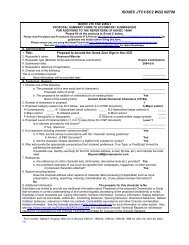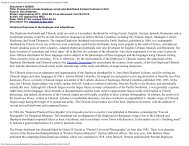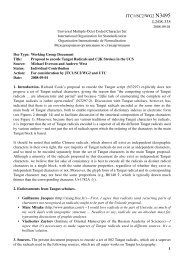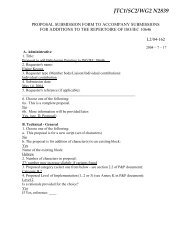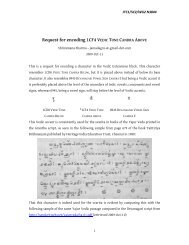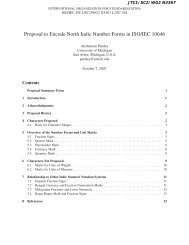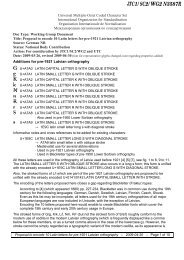ISO/IEC JTC1/SC2/WG2 N 4161R - DKUUG standardizing
ISO/IEC JTC1/SC2/WG2 N 4161R - DKUUG standardizing
ISO/IEC JTC1/SC2/WG2 N 4161R - DKUUG standardizing
You also want an ePaper? Increase the reach of your titles
YUMPU automatically turns print PDFs into web optimized ePapers that Google loves.
and could still be pursued by the Hungary MB. Furthermore, until the amendment is finalized the repertoire can be<br />
augmented and re-ordered.<br />
2. The term “Old Hungarian” is already used by Hungarian linguists for denoting the medieval version of the<br />
Hungarian Latin-based script, which is wildly different to the Szekely-Hungarian Rovas script (for<br />
instance, see Ch. 3 of N4120 (2011-07-05)). Therefore, using the term “Old Hungarian” for the<br />
Szekely-Hungarian Rovas is misleading. More details about the Old Hungarian script:<br />
http://wiki.rovas.info/index.php/Old_Hungarian_script<br />
3. The Szekely-Hungarian Rovas script has been developed ca. the end 8h c., in the Ancient Hungarian<br />
linguistic period (1st millennium BC – 896 AD), before the Old Hungarian linguistic period (896-1526).<br />
Consequently, using the name “Old Hungarian script” for an earlier script would be misleading.<br />
4. Using the expression “Old Hungarian” for denoting the Szekely-Hungarian Rovas has no tradition either<br />
in Hungarian culture or in the script history.<br />
Propose noted<br />
See disposition of comment T1.<br />
Moreover, there are several arguments for the term “Szekely-Hungarian Rovas”:<br />
5. The variety of traditional names for this script usually contains adjectives; the most frequent ones being<br />
“Szekely” and “Hungarian”. Therefore, the widely accepted name “Szekely-Hungarian Rovas” correctly<br />
reflects the traditional naming. The Hungarian ethnic group Szekelys played a key role in preserving the<br />
tradition of Szekely-Hungarian Rovas and regard this script as key part of their identity.<br />
6. Throughout history, the term Rovas has been widely used, moreover having found common use in the<br />
Hungarian language today. Although the term “Rovas” is of Hungarian-origin, it has been widely used in<br />
numerous languages; see in the Ch. 4 of N4120 (2011-07-05).<br />
7. The Rovas using community organized the “Living Rovas” Conference in 2008, in Hungary, which was<br />
the largest ever Rovas user/researcher meeting. At this conference, after a detailed discussion, the<br />
attendance made the resolution that the English name of the script is “Szekely-Hungarian Rovas” – being<br />
the correct translation of the appropriate Hungarian term “székely-magyar rovás”.<br />
8. The term “Rovas” is a category name; three related scripts belong to this script family, namely:<br />
Szekely-Hungarian Rovas, Carpathian Basin Rovas (see N4144, 2011-10-12), and Khazarian Rovas (see<br />
N4145, 2011-10-12). The close relation of Carpathian Basin Rovas to Szekely-Hungarian Rovas has been<br />
shown by linguist and Turkologist Gyula Németh in 1932. Moreover, according to the<br />
archaeologist-historian István Erdélyi, the Khazarian Rovas is related to Carpathian Basin Rovas and<br />
Szekely-Hungarian Rovas. More details about the Rovas script family:<br />
http://wiki.rovas.info/index.php/Rovas_Script_Family<br />
Propose Noted<br />
See disposition of comment T1.<br />
9. The research into the field of the Rovas scripts are mainly published in Hungarian and only little<br />
information is available in English. Consequently, the English databases are outdated in most cases.<br />
Especially, the results of the last 2-3 decades are missing from western literature as only a small portion of<br />
the Hungarian publications on this topic have been translated. The contributions of the Hungarian NB use<br />
and refer to the results of international and the Hungarian scholars.<br />
Page 9



